I will admit- given the premise of the game Akiba’s Trip, a game where the plot and gameplay revolve around stripping people naked of their clothes in order to defeat them- I went into this review expecting a shallow fanservice game with little story or replay value beyond; Well, you know.
Instead, I was surprised to find that Akiba’s Trip was a well written adventure meant as a love letter to the town the game was named after. While this game definitely has its rough edges, this finally localized first entry in the Akiba’s Trip series serves a great entry point for those like me who have never given the series a chance up until this point.
This is a review coupled with a supplemental video review. You can watch the video review or read the full review of the game below.
AKIBA’S TRIP: Hellbound & Debriefed
Developer: Acquire
Publisher: XSEED Games, Marvelous USA
Platforms: Windows PC, Nintendo Switch, PlayStation 4
Release Date: July 20th, 2021
Players: 1
Price: $39.99 USD
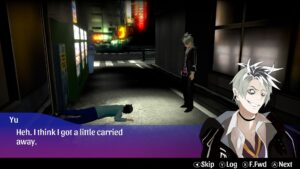
The premise of the game goes as follows. After finding your friend attacked and left for dead in an alleyway, you come across his assailant: a hot-headed vampire, part of a race known as the Shadow Souls. After getting beat to near death by him, your assailant’s sister- also a shadow soul- decided to give you some of her blood, healing you and giving you the powers of a Shadow Soul.
Shortly after, you get conscripted to join a government organization that wants to use your power to stop the Shadow Souls for good. You find out these Shadow Souls have been draining the citizens of Japan, and the district of Akihabara specifically, in order to turn them into depressed shut-ins; thus destroying the country from the inside.
While I don’t believe the game ever has the word “vampire” be mentioned, for all intents and purposes that is what Shadow Souls and you have become. Just like vampires they do not age, suck out peoples’ life force, can’t be seen on film, and most importantly die to sunlight.
However, unlike most fictional portrayals, in Akiba’s Trip (or also pronounced Akiba STRIP), these vampires can survive in the sunlight as long as they have protective clothes on. So, it is your job to strip them of everything but their undergarments to defeat them, while at the same time avoiding being stripped yourself.

“Yeah Yeah, nice excuse for fan service,” I told myself. So when do the lewd scenes start? What confused me by this point, around 10 minutes in, is that not only was there quite a bit of dialog for a game about stripping people naked, but the music gave off a serious, almost nostalgic vibe to it.
Something you only ever hear in Japanese games trying to be taken semi seriously, or H-games so perverse that they treat their degenerate acts as a serious matter; but definitely not something you would hear in a silly fanservice game aimed at otaku with no intent in taking itself seriously.
What I slowly came to realize was, that despite its premise, Akiba’s Trip was actually more focused on being a love letter to the district of Akihabara (often shortened to just Akiba and it’s local community) than it was trying to be another horny game like Senran Kagura.
By most anime standards, the fan service of this game is actually kept to a minimum, while the game tries to tell a semi-serious story using its silly premise. I had to double check, and was actually surprised that the game received an M rating; because outside of an F-bomb said maybe twice throughout the game, the sexual themes and violence are no worse than what you would find in your average shounen anime.
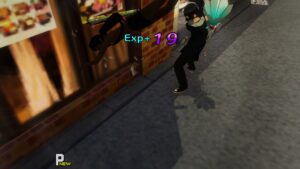
After all, when a character is fully stripped, they instantly burn to ash. While personal tastes are a bit subjective, I never found any of the characters male or female to be that sexy. Sexuality is definitely a theme in this game and is used for comedic effect, but some viewers might be disappointed to find out that Akiba’s Trip doesn’t deliver on the eye candy like they may have first expected.
Graphically, there is no hiding it. Akiba’s Trip is a PSP game ported to modern systems, with a few small graphical options like resolution added, and given a worldwide release rather than the Japanese exclusive one it had back in 2011. While I think most areas don’t look too bad, you will find textures and character models that will remind that yes, this was something that was running on a PSP.
I personally don’t mind this too much, however the PSPs hardware limitations effect the game in far worse ways than just it’s low-resolution textures. For one, areas in this game are small, and going from one area to another requires you to load to a select screen, then load to the area you want to travel to.
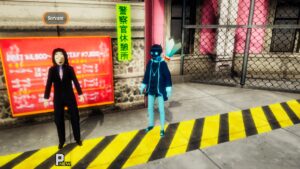
While I tend to prefer small thought-out maps to that of the big empty ones that have been flooding the market over the last few years; I wish the developers went through the trouble of sticking together the different locations of Akihabara into one map for this re-release, as opposed to how it is currently handled.
Considering how small the maps are, it would have been easier to have my character walk to those locations than it is to walk off the edge the map, have my character load into the map select screen, then have him load into the next area.
I find this sad because despite the graphical and size limitations, it’s clear the developers went through a lot of trouble to properly capture the layout and design of the district of the Akihabara strip as closely as the hardware limitations of the PSP would allow.
In the west, it is rare outside of New York for games to take place in real life locations, and rarer for them to have such a faithful recreation. The areas you visit have their designs, layouts, and shops based on the actual real-world locations of Akihabara from the year 2011. During loading screens they even show you real life pictures of the locations present in the game, so you can compare for yourself.
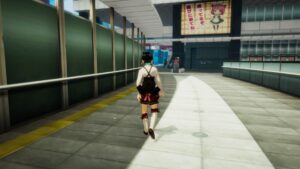
But the PSP limitations show themselves in what is the worst part of the game: the combat. The basics of Akiba’s combat are as follows. You defeat enemies by stripping them of their clothes, they defeat you by stripping you of your clothes. You do this by damaging their clothes until it is weak enough that you can rip it off.
You have 3 different basics attacks. Y or triangle which targets head gear, X or Square which targets the clothes on an enemies’ shirt or blouse, or A or cross which target an enemies’ leg wear. Each of these three clothing areas have separate health bars. The player also unlocks special moves throughout the game which require more complex inputs and time to perform, but cause more damage or buffs the player.
The player’s attack damage and defense are based on what clothes you are wearing, and what item you are using as a weapon. Akiba’s Trip celebrates the silliness of the otaku capital by allowing players to attack enemies with waifu pillows, action figures, guitars, and more. These can be bought in shops along with consumables which can help you out in battle.
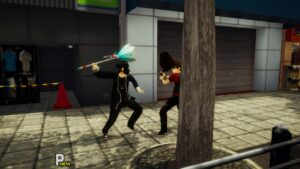
Combat in the first Akiba’s Trip was designed around the limited number of buttons of the PSP. Camera controls are limited, leading to frustrations. Locking onto enemies is automatic, giving the player no real reliable way to choose who the player should direct their attacks at, and worst of all the more complex attacks by the player feel inconsistent.
I can reliably input super attacks in most fighting games yet, despite the inputs required being generally far less complex in Akiba’s Trip, I find them hard to do consistently.
Not only that, but an attack landing or being interrupted feels more chance-based than it does skill-based, meaning simply spamming light attacks is often times the most viable option. Once long animation starts, it’s up to the AI if they want to attack you to cancel your attack wind up or not.
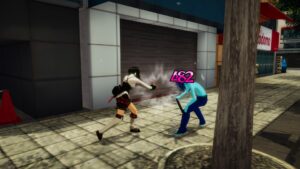
Some attacks require me to press the same button that is also is used to go in and out of my character’s combat stance. Sometimes I press it and it works, and other times my character stops fighting or blocking, leading to me getting hit over and over again.
These issues I described are things that got partially solved in the series sequels, making me really wish the developer, ACQUIRE Corp, was willing to put these quality of life features into this game. If they did that, I would be willing to refer to this game as a remake as opposed to a simple port.
Despite these major complaints, the consequences for death aren’t harsh enough to cause major frustration when you lose, because once you die you are sent right back to the map select screen; allowing you to usually instantly retry the battle.
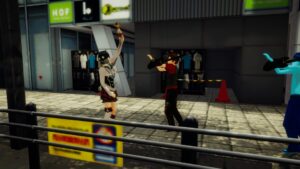
Also, there is something simply satisfying about causing the clothes of your opponent to explode away after damaging it enough. The closest example I can think of involving a similar feeling is when you shoot an enemy in an old FPS, and their body instantly gibs into meat chunks.
Replace gore with PG level fanservice, and the satisfaction stays surprisingly intact. On top of that, the combat is so flashy and silly that despite all the major complaints I had with it, I was never dreading combat encounters; something which I can’t say for a lot of other JRPGs I have played throughout the years.
While the combat of this game is at best serviceable, what truly makes up for it to me was the writing and characters. Every character is likable, and you actually begin to care about the mystery surrounding the Shadow Souls and agency fighting them.
But what really made this game an enjoyable experience for me was the members of the Akiba Freedom fighters. Your friends and comrades made up mostly of the local youth from around Akihabara.
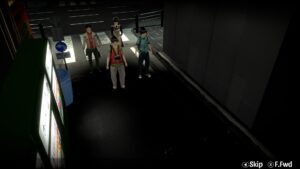
They each have distinct personalities, and I always had a smile on my face when listening to their dialog. As I said before, this game is a love letter to Akihabara, and it shows. Akihabara is more than just the settings of this game, Akiba’s Trip serves as one big advertisement to visit the place.
Instead of long rants about the powers of friendship you see in most JRPGs, characters in this game go into long speeches about how Akihabara is just a magical and unique place and how important it is to protect it. While I have visited and loved my time in Japan, I sadly have yet to visit Akihabara, after playing this game, I feel like I have to at some point.
The game even has it’s own version of Twitter called Pitter, where you hear characters cry about the idea of Akihabara slowly becoming a corporate town. The game uses it’s likable characters and recurring NPCs to make you actually care about this area and it’s people.
That is this games biggest strength. Getting you invested in the district, it’s characters, and the plot; and using that to motivate the player to continue playing the game.
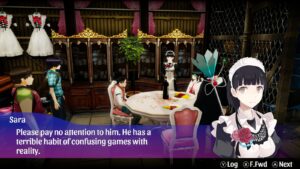
Despite it’s small size, Akihabara does have some distractions. Mini games, a maid café, and side missions give you something to do if you get burnt out on the main missions. This is definitely no Yakuza, but I am happy that the devs went through the trouble in order to spice things up.
You can also visit your tsundere little sister. While I personally find her annoying, you can dress her up, have her insult you, or have her look up info on specific items. While I said Akiba’s Trip wasn’t as horny as I thought, it is still a Japanese game, and therefore is contractually obligated to have incest play a part in the game somewhere.
In order to ensure replay value, Akiba’s Trip gives you multiple endings and difficulties to try and unlock. Your dialog options can actually make big changes to the games story, and determines who you side with; something which I personally find almost necessary in a role-playing game, yet is sadly missing in most JRPGs.
While getting my first ending only took around 10 hours to complete, replaying to choose certain decisions and restarting to try to unlock the different routes can more than double this playtime.
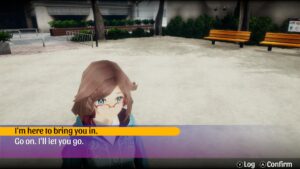
While the dialog itself motivated me to play past my single playthrough, I am not sure how people will react to the voice acting itself. While I wouldn’t consider the dub bad by most dub standards, I have listened to enough anime and JRPG dubs that I can instantly recognize the majority of voice actors in this game.
This is a problem that effects many English dubs, and makes me wonder why more voice actors aren’t hired to spice things up, though that is an industry issue as a whole. Another issue I found with the dub is that the sound mixing wasn’t the best. Often times the music was far louder than the characters speaking, which required me to fix by manually adjusting in the options menu.
The music itself is decent. As I said before, it correctly sets the tone for what is generally an actually serious story. Shop music however reminds me of a discount The World Ends With You though with it’s soft low energy rap.

In conclusion, despite Akiba’s Trip: Hellbound & Debriefed many flaws, I can’t bring myself to hate it. It’s characters and writing are charming, and the district itself brings a personality all its own.
I can already tell that this is going to be a cult game in the west. Something that may be too frustrating and outdated for some, but just the thing for those who are looking for that specific comfy feel. That memory of youth, hanging out with friends on a weekend in your local downtown area, a place you know better than the back of your hand.
That’s the feeling this game gives it’s players. I can’t imagine what this game must be like for those who actually lived in Akihabara, but I bet it is something that can give them a sense of pride.
Akiba’s Trip: Hellbound & Debriefed was reviewed on PC using a review copy provided by XSEED. You can find additional information about Niche Gamer’s review/ethics policy here.